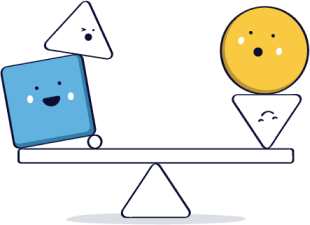
The best-performing teams don’t just get along—they harness cognitive diversity, constructive tension, and mutual respect to challenge assumptions and drive innovation.
But while harmony feels efficient, true progress often comes from friction between differing perspectives, as long as it’s managed with trust and shared goals.
The takeaway? B2B teams should embrace diverse thinking and productive conflict to unlock creativity, solve complex problems, and outperform the status quo.
The following is excerpted from Dream Teams: Working Together Without Falling Apart by bestselling author and Contently cofounder Shane Snow. For more, follow Shane on Medium, Twitter, and LinkedIn.
Summarize this content with AI:
***********
Pretend that you are having a housewarming party, and you’ve invited your eight best friends. You’ve baked a delicious round cake, and because you love your friends equally, you want to cut it into eight equal pieces for them.
But there’s a catch: the knife you are using, for whatever reason, is going to break after you make three cuts. How do you slice the cake into eight equal pieces in just three moves?
If you’re like most people, you probably first cut the cake in half vertically:
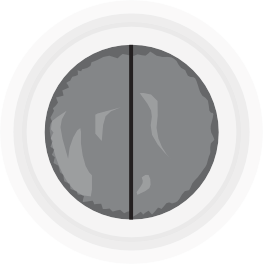
Then you cut it in half horizontally:
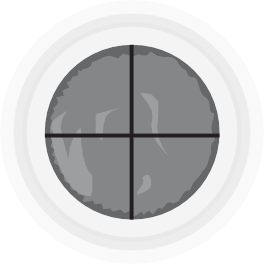
And then, again, if you’re like most people, you’ll start making a third and final cut diagonally before realizing that this only makes six slices of cake:
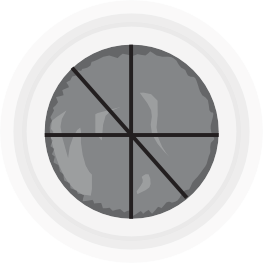
So what do you do?
At this point, you might try to get fancy and diagram out some funny-looking cake slices, but then you’ll remember that the pieces have to be equal for your friends to know you love them the same.
There is a simple answer, though. It just requires changing your point of view.
The solution is to go ahead and make the first two cuts, creating four slices of cake, and then to turn your head and look at the cake sideways:

And cut it all the way through.
This little puzzle illustrates something important. It shows us in a very literal way a simple truth, that sometimes the best way to solve a problem requires looking at it from a different angle. In other words, to change perspective.
Perspective is built by how we uniquely experience the world. A bystander who sees a building on fire might perceive what’s happening very differently from a firefighter, or from a person who once had his house burn down. When you ask tall people what makes for a good airline, most of them will tell you “legroom,” while short people will tell you “elbow room.” Neither answer is incorrect in this case, depending on whether you see the world from six inches higher off the ground.
Perspective is one dimension of every person’s mental tool kit. To introduce the other dimension, we return to our housewarming party for another puzzle.
Pretend that next to the cake at your kitchen table are six glasses lined up in a row. The first three glasses are full of milk. The next three are empty. Like so:

Now, say I asked you to move the glasses so that the full and empty cups alternate. But there’s a catch: you can only move one glass.
Can you do it?
For most people, this one is a bigger head-scratcher than the cake. Most of us try to move the second glass of milk to sit in between two empty glasses, only to realize that it still leaves two full glasses next to each other.

If you’re still stumped, try this:
Pretend that I asked you to solve this same puzzle, but that I also told you to pretend that you had to use the technique of a chemist to do it.
If you were stumped before, at this point the answer may have suddenly become obvious.
Pour the milk from the second glass into the second to last glass, and put the glass back.

This puzzle helps us understand the second dimension of a person’s mental tool kit: something called heuristics. If perspective is how we see a problem, heuristics are how we go about solving it. You can think of heuristics as “rules of thumb” or problem-solving strategies.
The way a chemist’s brain instinctively attempts the milk puzzle is likely going to be different from the way, say, a forklift operator’s brain does. This isn’t to say that forklift operators wouldn’t be able to solve the milk puzzle. What it says is that if you move objects around all day with a forklift, your first strategy for rearranging glasses of milk is likely going to be different than if your job is to pour liquids in and out of containers all day.
Choose the model that best fits your business and see how we help teams like yours close more deals.

These two parts of our mental tool kit—perspective and heuristics—go hand in hand. And they explain what’s actually important when it comes to working together. To understand what I mean, let’s look at the following diagram of a mountain range:

This mountain range represents the set of potential solutions to a hypothetical problem. Each peak represents a different solution. The higher the peak, the better the solution. Every problem in life or work can be represented by its own unique mountain range like this, with varying quality of solutions.
As you can see, some solutions to our hypothetical problem are not as good as others. And in this case there is one best solution—the highest peak in the middle.
Unfortunately, when we’re exploring real problems, it is as if we’re hiking through fog. We can’t actually see the entire mountain range. This means that when we find a peak—a solution that works—we don’t know if we’re at the top of the range or just the top of one mountain. We have to decide whether to continue exploring for a better solution.
And here’s where our cake analogy comes back. Where we start out on the mountain—and what part of it we can see—depends on our perspective. It’s like getting dropped off by helicopter at a particular spot on the range:

Now that we’re here, we need a strategy—or heuristic—to help us explore for solutions.
Let’s say you have one mountain heuristic, and it is to march in one direction until the mountain stops going up, and then to climb down the other side for five hundred paces. If the slope turns back uphill by then, you keep hiking upward until you reach the next peak. But if you go downhill for five hundred paces and the slope keeps going down, you turn around and hike up to the last highest point you found.
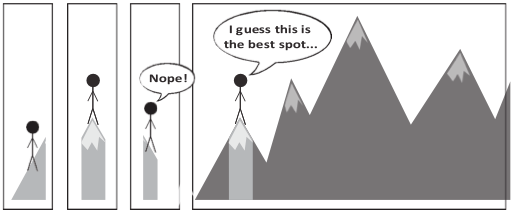
As we can see, your perspective and heuristic helped you find a decent solution, but little did you know there were other, better solutions out there.
This is where teamwork can help. Say you’re working with someone who shares a similar perspective on the problem you’re working on. He’ll get dropped off at the same place on the mountain range as you originally did.
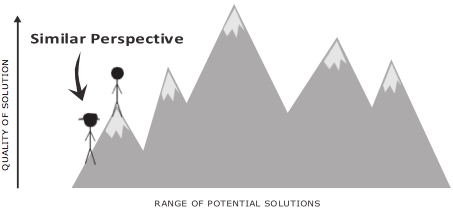
But let’s say that your teammate has a different mountain-climbing heuristic than yours. His strategy is to hike until he reaches the trough between two mountains, and then to go up whichever one is steepest. Using this technique, he might continue past you and find that the next mountain over has a higher peak.

It turns out that our teammate’s diverse heuristic allowed him to find a better solution. He then calls down from his mountain peak at this point, and you join him.
This is how group work often happens. Whoever in the group has the best heuristic will eventually find the best solution, and the group (hopefully) follows it. This is why we put people with different specialties together—such as pairing a design expert and a programming expert together to build a website.
With this strategy, however, eventually your group will run into a problem. No matter how many people are in your crew, if you all start on the mountain from a similar perspective, the group will eventually get stuck together on one peak.
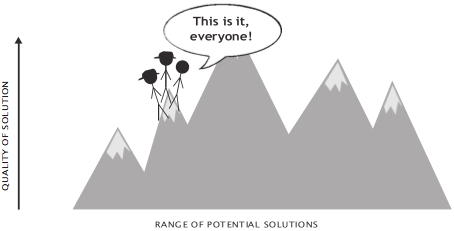
But this is where something interesting can happen.
When you introduce someone with a different perspective, it’s like she is getting dropped off on a different part of the mountain range altogether. She sees it from a point of view that the rest of the group doesn’t.
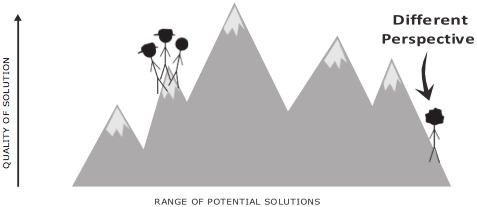
So let’s say this happens. One of your team members shows up with a very different perspective of your mountain range. Even if she has the same heuristics as you (say you went to mountain climbing school together) and explores the mountain using your “five hundred paces” strategy, she might end up finding a better solution simply because she started in a different place.
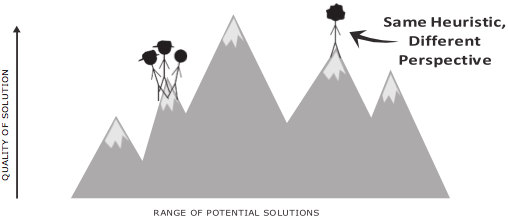
But even if she doesn’t end up finding a better solution than the rest of the group, her vantage point offers the group an opportunity. The group can now play with different combinations of perspectives and heuristics to test if there are higher peaks to be found. In this case, the heuristic of hiking to the trough and going up the steep way, combined with the new perspective, reveals the highest peak in the range.
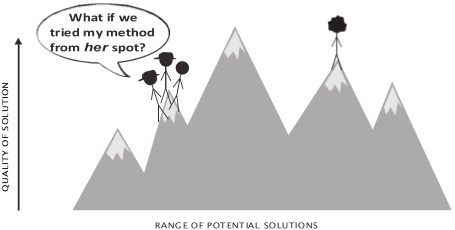
Thus, the whole group is able to get to a solution that nobody would have found on his or her own. The ne plus ultra of the mountain range.
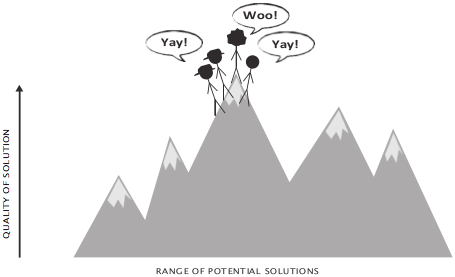
This is the math, as it were, behind the concept of “synergy.” The combination of diverse mental tool kits—looking at the cake sideways and moving the milk glasses differently—leads to the potential for a group to do better than the sum of its parts. It explains how a whole squad of smart people who think the same is less likely to find a higher peak on the mountain than a group of people who think differently.
***********
Excerpted from Dream Teams: Working Together Without Falling Apart by Shane Snow, in agreement with Portfolio, an imprint of Penguin Publishing Group, a division of Penguin Random House LLC. Copyright © Shane Snow, 2018.
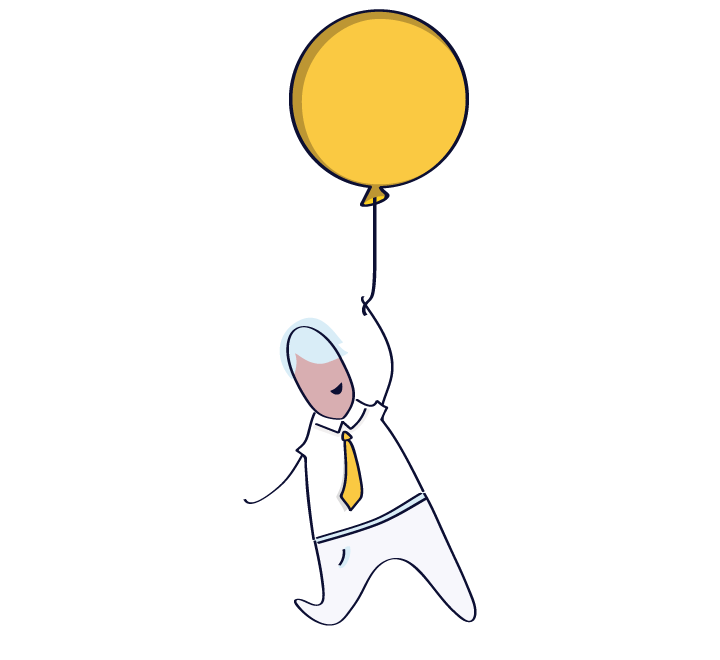
Join 30,000+ other sales and marketing professionals. Subscribe to our Sell to Win newsletter!
 Email & Calendar Sync
Email & Calendar Sync
Use our calculator to add up your total investment of CRM and Add-ons
VIEW ALL PRICING
 Product Info
Product Info Education & Guides
Education & Guides Company
Company